Diagnosing Hydraulic Fracture Geometry, Complexity, and Fracture Wellbore Connectivity Using Chemical Tracer Flowback †
Abstract
1. Introduction
2. Model Description
2.1. Fluid Flow and Geomechanics Model
2.2. Fracture Closure Model
2.3. Mathematical Formulation for Tracer Transport
2.4. Tracer Transport Model in the Reservoir Domain
2.5. Tracer Transport Model in the Fracture Domain
2.6. Coupling of Matrix and Fracture Domain Tracer Equations
2.7. Solution Algorithm
2.8. Multiple Tracer Option
3. Tracer Flowback Simulations with Fracture Propagation
3.1. Impact of Fracture Length on Tracer Response Curves
3.2. Impact of Fracture Closure on Tracer Flowback
3.3. Effect of Fracture Complexity
4. Fracture Wellbore Connectivity Using Chemical Tracer Flowback
4.1. Complicated Tracer Response Curves Typically Observed in a Field Tracer Test
4.2. Simulation Model Description
4.3. Multiple Peaks in the Tracer Response Curve Due to the Fracture Closure in a Complex Fracture Network
4.4. Impact of Fracture Closure on the Tracer Recovery from Complex Fractures
4.5. Tracer Recovery vs. Hydrocarbon Production
4.6. Inverse Modeling with Neural Network
- Tracer recovery
- Number of peaks
- First peak concentration
- First peak time
5. Conclusions
- Multiple peaks in the tracer response curves can be explained by the closure of IU fractures during flowback.
- Tracer recovery (%) and the number of peaks can help determine the fraction of the created fracture area that is open and connected to the wellbore.
- Early time peaks correlate with fracture closure occurring near the wellbore. Late time peaks are observed due to tracer flowback from fractures that are connected to the wellbore through IU fractures.
- The area under the early time peak is directly correlated with the fraction of created fracture area that is in good hydraulic communication with the wellbore.
- The area under later peaks is related to the area of the fracture that is only connected to the wellbore through induced unpropped (IU) fractures. The timing of these peaks is related to the conductivity of the IU fractures.
- Low tracer recovery typically observed in the field can be explained by the closure of induced unpropped fractures and low initial water saturation in the reservoir.
- Production from a stage is directly proportional to the tracer recovery from that stage. This can help in comparing the production performance of a fracture stage with respect to overall flow from a multi-fractured well.
Author Contributions
Funding
Acknowledgments
Conflicts of Interest
References
- Warpinski, R.N.; Sullivan, R.B.; Uhl, J.; Waltman, C.; Machovoie, S. Improved microseismic fracture mapping using perforation timing measurements for velocity calibration. SPE J. 2005, 10, 14–23. [Google Scholar] [CrossRef]
- Mayerhofer, J.M.; Lolon, E.P.; Youngblood, J.E.; Heinze, J.R. Integration of microseismic-fracture-mapping results with numerical fracture network production modeling in the Barnett Shale. In Proceedings of the SPE Annual Technical Conference and Exhibition, San Antonio, TX, USA, 24–27 September 2006; Society of Petroleum Engineers: Richardson, TX, USA, 2006. [Google Scholar] [CrossRef]
- Wright, A.C.; Davis, E.J.; Golich, G.M.; Ward, J.F.; Demetrius, S.L.; Minner, W.A.; Weijers, L. Downhole tiltmeter fracture mapping: Finally measuring hydraulic fracture dimensions. In Proceedings of the SPE Western Regional Meeting, Bakersfield, CA, USA, 10–13 May 1998; Society of Petroleum Engineers: Richardson, TX, USA, 1998. [Google Scholar] [CrossRef]
- Cipolla, L.C.; Mayerhofer, M. Understanding fracture performance by integrating well testing & fracture modeling. In Proceedings of the SPE Annual Technical Conference and Exhibition, New Orleans, LA, USA, 27–30 September 1998; Society of Petroleum Engineers: Richardson, TX, USA, 1998. [Google Scholar] [CrossRef]
- Scott, P.M.; Johnson, R.L.; Datey, A.; Vandenborn, C.B.; Woodroof, A.R. Evaluating hydraulic fracture geometry from sonic anisotropy and radioactive tracer logs. In Proceedings of the SPE Asia Pacific Oil and Gas Conference and Exhibition, Brisbane, Australia, 18–20 October 2010; Society of Petroleum Engineers: Richardson, TX, USA, 2010. [Google Scholar] [CrossRef]
- Gardien, J.C.; Pope, G.A.; Hill, A.D. Hydraulic fracture diagnosis using chemical tracers. In Proceedings of the SPE Annual Technical Conference and Exhibition, Denver, CO, USA, 6–9 October 1996; Society of Petroleum Engineers: Richardson, TX, USA, 1996. [Google Scholar]
- Leong, Y.; de Iongh, J.E.; Bähring, S.; Tuxen, A.K.; Nielsen, T.B. Estimation of fracture volume between well pairs using deuterium tracer. In Proceedings of the SPE Annual Technical Conference and Exhibition, Houston, TX, USA, 28–30 September 2015; Society of Petroleum Engineers: Richardson, TX, USA, 2015. [Google Scholar]
- Awada, A.; Santo, M.; Lougheed, D.; Xu, D.; Virues, C. Is That Interference? A Workflow for Identifying and Analyzing Communication Through Hydraulic Fractures in a Multi-Well Pad. In Proceedings of the Unconventional Resources Technology Conference, San Antonio, TX, USA, 20–22 July 2015. [Google Scholar] [CrossRef]
- Seth, P.; Manchanda, R.; Kumar, A.; Sharma, M. Estimating hydraulic fracture geometry by analyzing the pressure interference between fractured horizontal wells. In Proceedings of the SPE Annual Technical Conference and Exhibition, Dallas, TX, USA, 24–26 September 2018; Society of Petroleum Engineers: Richardson, TX, USA, 2018. [Google Scholar]
- Seth, P.; Shrivastava, K.; Kumar, A.; Sharma, M.M. Pressure Interference between Fractured Horizontal Wells: Impact of Complex Fracture Growth on Offset Well Pressure Measurements. In Proceedings of the 53rd US Rock Mechanics/Geomechanics Symposium, New York, NY, USA, 23–26 June 2019; American Rock Mechanics Association: Alexandria, VA, USA, 2019. [Google Scholar]
- Carey, A.M.; Mondal, S.; Sharma, M.M. Analysis of water hammer signatures for fracture diagnostics. In Proceedings of the SPE Annual Technical Conference and Exhibition, Houston, TX, USA, 28–30 September 2015; Society of Petroleum Engineers: Richardson, TX, USA, 2015. [Google Scholar] [CrossRef]
- Du, Y.; Guan, L. Interwell tracer tests: Lessons learnted from past field studies. In Proceedings of the SPE Asia Pacific Oil and Gas Conference and Exhibition, Jakarta, Indonesia, 5–7 April 2005; Society of Petroleum Engineers: Richardson, TX, USA, 2005. [Google Scholar] [CrossRef]
- Wagner, O.R. The use of tracers in diagnosing interwell reservoir heterogeneities-Field results. J. Petrol. Technol. 1977, 29, 1–410. [Google Scholar] [CrossRef]
- Deans, H.A. Method of Determining Fluid Saturations in Reservoirs. U.S. Patent 3,623,842, 30 November 1971. [Google Scholar]
- Khaledialidusti, R.; Kleppe, J. A comprehensive framework for the theoretical assessment of the single-well-chemical-tracer tests. J. Petrol. Sci. Eng. 2017, 159, 164–181. [Google Scholar] [CrossRef]
- Mulkern, E.M.; Asadi, M.; McCallun, S. Fracture extent and zonal communication evaluation using chemical gas tracers. In Proceedings of the SPE Eastern Regional Meeting, Morgantown, WV, USA, 12–14 October 2010; Society of Petroleum Engineers: Richardson, TX, USA, 2010. [Google Scholar] [CrossRef]
- Kumar, A.; Seth, P.; Shrivastava, K.; Manchanda, R.; Sharma, M.M. Well interference diagnosis through integrated analysis of tracer and pressure interference tests. In Proceedings of the Unconventional Resources Technology Conference, Houston, TX, USA, 23–25 July 2018; Society of Exploration Geophysicists: Houston, TX, USA; American Association of Petroleum Geologists: Tulsa, OK, USA; Society of Petroleum Engineers: Richardson, TX, USA, 2018; pp. 1404–1415. [Google Scholar] [CrossRef]
- Kumar, A.; Seth, P.; Shrivastava, K.; Manchanda, R.; Sharma, M.M. Integrated Analysis of Tracer and Pressure-Interference Tests To Identify Well Interference. SPE J. 2020. [Google Scholar] [CrossRef]
- Catlett, D.R.; Spencer, J.D.; Lolon, E.; Bucior, D. Evaluation of two horizontal wells in the eagle ford using oil-based chemical tracer technology to optimize stimulation design. In Proceedings of the SPE Hydraulic Fracturing Technology Conference, The Woodlands, TX, USA, 4–6 February 2013; Society of Petroleum Engineers: Richardson, TX, USA, 2013. [Google Scholar] [CrossRef]
- Goswick, A.R.; LaRue, J.L. Utilizing oil soluble tracers to understand stimulation efficiency along the lateral. In Proceedings of the SPE Annual Technical Conference and Exhibition, Amsterdam, The Netherlands, 27–29 October 2014; Society of Petroleum Engineers: Richardson, TX, USA, 2014. [Google Scholar] [CrossRef]
- Elahi, H.S.; Jafarpour, B. Dynamic fracture characterization from tracer-test and flow-rate data with ensemble Kalman filter. SPE J 2018, 23, 449–466. [Google Scholar] [CrossRef]
- Tian, W.; Shen, T.; Liu, J.; Wu, X. Hydraulic fracture diagnosis using partitioning tracer in shale gas reservoir. In Proceedings of the SPE Asia Pacific Hydraulic Fracturing Conference, Beijing, China, 24–26 August 2016; Society of Petroleum Engineers: Richardson, TX, USA, 2016. [Google Scholar]
- Li, L.; Pinprayong, V.; Meng, F.; Jiang, H.; Li, J. Fracture Network Evaluation Using Tracer Flowback: A Case Study. In Proceedings of the SPE Symposium: Production Enhancement and Cost Optimisation, Kuala Lumpur, Malaysia, 7–8 November 2017; Society of Petroleum Engineers: Richardson, TX, USA, 2017. [Google Scholar]
- Li, L.; Jiang, H.; Wu, K.; Li, J.; Chen, Z. An analysis of tracer flowback profiles to reduce uncertainty in fracture-network geometries. J. Petrol. Sci. Eng. 2019, 173, 246–257. [Google Scholar] [CrossRef]
- Zheng, S.; Kumar, A.; Gala, D.P.; Shrivastava, K.; Sharma, M.M. Simulating Production from Complex Fracture Networks: Impact of Geomechanics and Closure of Propped/Unpropped Fractures. In Proceedings of the Unconventional Resources Technology Conference, Denver, CO, USA, 22–24 July 2019; Society of Exploration Geophysicists: Houston, TX, USA, 2019; pp. 2322–2338. [Google Scholar] [CrossRef]
- Agca, C.; Pope, G.A.; Sepehrnoori, K. Modelling and analysis of tracer flow in oil reservoirs. J. Petrol. Sci. Eng. 1990, 4, 3–19. [Google Scholar] [CrossRef]
- Bryant, C.E.; Hwang, J.; Sharma, M.M. Arbitrary fracture propagation in heterogeneous poroelastic formations using a finite volume-based cohesive zone model. In Proceedings of the SPE Hydraulic Fracturing Technology Conference, The Woodlands, TX, USA, 3–5 February 2015; Society of Petroleum Engineers: Richardson, TX, USA, 2015. [Google Scholar] [CrossRef]
- Bandis, C.S.; Lumsden, A.C.; Barton, N.R. Fundamentals of rock joint deformation. Int. J. Rock Mech. Min. Sci. Geomech. Abstr. 1983, 20, 249–268. [Google Scholar] [CrossRef]
- Seth, P.; Kumar, A.; Manchanda, R.; Shrivastava, K.; Sharma, M.M. Hydraulic Fracture Closure in a Poroelastic Medium and its Implications on Productivity. In Proceedings of the 52nd US Rock Mechanics/Geomechanics Symposium, Seattle, WA, USA, 17–20 June 2018; American Rock Mechanics Association: Alexandria, VA, USA, 2018. [Google Scholar]
- Lake, L.W. Enhanced Oil Recovery; Prentice Hall: Upper Saddle River, NJ, USA, 1989. [Google Scholar]
- Jin, M.; Delshad, M.; Dwarakanath, V.; McKinney, D.C.; Pope, G.A.; Sepehrnoori, K.; Tilburg, C.E.; Jackson, R.E. Partitioning tracer test for detection, estimation, and remediation performance assessment of subsurface nonaqueous phase liquids. Water Resour. Res. 1995, 31, 1201–1211. [Google Scholar] [CrossRef]
- Zemel, B. Tracers in the Oil Field; Elsevier: Amsterdam, The Netherlands, 1995. [Google Scholar]
- Bryant, E.C. Hydraulic Fracture Modeling with Finite Volumes and Areas. Ph.D. Thesis, The University of Texas at Austin, Austin, TX, USA, 2016. [Google Scholar]
- Zheng, S.; Manchanda, R.; Sharma, M.M. Development of a fully implicit 3-D geomechanical fracture simulator. J. Petrol. Sci. Eng. 2019, 179, 758–775. [Google Scholar] [CrossRef]
- Saad, Y.; Schultz, M.H. GMRES: A generalized minimal residual algorithm for solving nonsymmetric linear systems. SIAM J. Sci. Stat. Comput. 1986, 7, 856–869. [Google Scholar] [CrossRef]
- Saad, Y. ILUT: A dual threshold incomplete LU factorization. Numer. Linear Algebra Appl. 1994, 1, 387–402. [Google Scholar] [CrossRef]
- King, E.G.; Leonard, D. Utilizing fluid and proppant tracer results to analyze multi-fractured well flow back in shales: A framework for optimizing fracture design and application. In Proceedings of the SPE Hydraulic Fracturing Technology Conference, The Woodlands, TX, USA, 24–26 January 2011. [Google Scholar] [CrossRef]
- Johnston, B.P.; Atkinson, T.C.; Odling, N.E.; Barker, J.A. Models of tracer breakthrough and permeability in simple fractured porous media. Geol. Soc. Lond. Spec. Publ. 2005, 249, 91–102. [Google Scholar] [CrossRef]
- Fisher, K.M.; Wright, C.A.; Davidson, B.M.; Goodwin, A.K.; Fielder, E.O.; Buckler, W.S.; Steinsberger, N.P. Integrating fracture mapping technologies to optimize stimulations in the Barnett Shale. In Proceedings of the SPE Annual Technical Conference and Exhibition, San Antonio, TX, USA, 29 September–2 October 2002; Society of Petroleum Engineers: Richardson, TX, USA, 2002. [Google Scholar] [CrossRef]
- Weng, X.; Kresse, O.; Cohen, C.E.; Wu, R.; Gu, H. Modeling of hydraulic fracture network propagation in a naturally fractured formation. In Proceedings of the SPE Hydraulic Fracturing Technology Conference, The Woodlands, TX, USA, 24–26 January 2011; Society of Petroleum Engineers: Richardson, TX, USA, 2011. [Google Scholar] [CrossRef]
- Shrivastava, K.; Sharma, M.M. Mechanisms for the formation of complex fracture networks in naturally fractured rocks. In Proceedings of the SPE Hydraulic Fracturing Technology Conference and Exhibition, The Woodlands, TX, USA, 23–25 January 2018; Society of Petroleum Engineers: Richardson, TX, USA, 2018. [Google Scholar]
- Shrivastava, K.; Agrawal, S.; Kumar, A.; Sharma, M.M. 3-D interactions of hydraulic fractures with natural fractures. In Proceedings of the SPE International Hydraulic Fracturing Technology Conference and Exhibition, Muscat, Oman, 16–18 October 2018; Society of Petroleum Engineers: Richardson, TX, USA, 2018. [Google Scholar]
- Sharma, M.M.; Manchanda, R. The role of induced un-propped (IU) fractures in unconventional oil and gas wells. In Proceedings of the SPE Annual Technical Conference and Exhibition, Houston, TX, USA, 28–30 September 2015; Society of Petroleum Engineers: Richardson, TX, USA, 2015. [Google Scholar] [CrossRef]
- Kumar, A.; Seth, P.; Shrivastava, K.; Sharma, M.M. Optimizing drawdown strategies in wells producing from complex fracture networks. In Proceedings of the SPE International Hydraulic Fracturing Technology Conference and Exhibition, Muscat, Oman, 16–18 October 2018; Society of Petroleum Engineers: Richardson, TX, USA, 2018. [Google Scholar] [CrossRef]
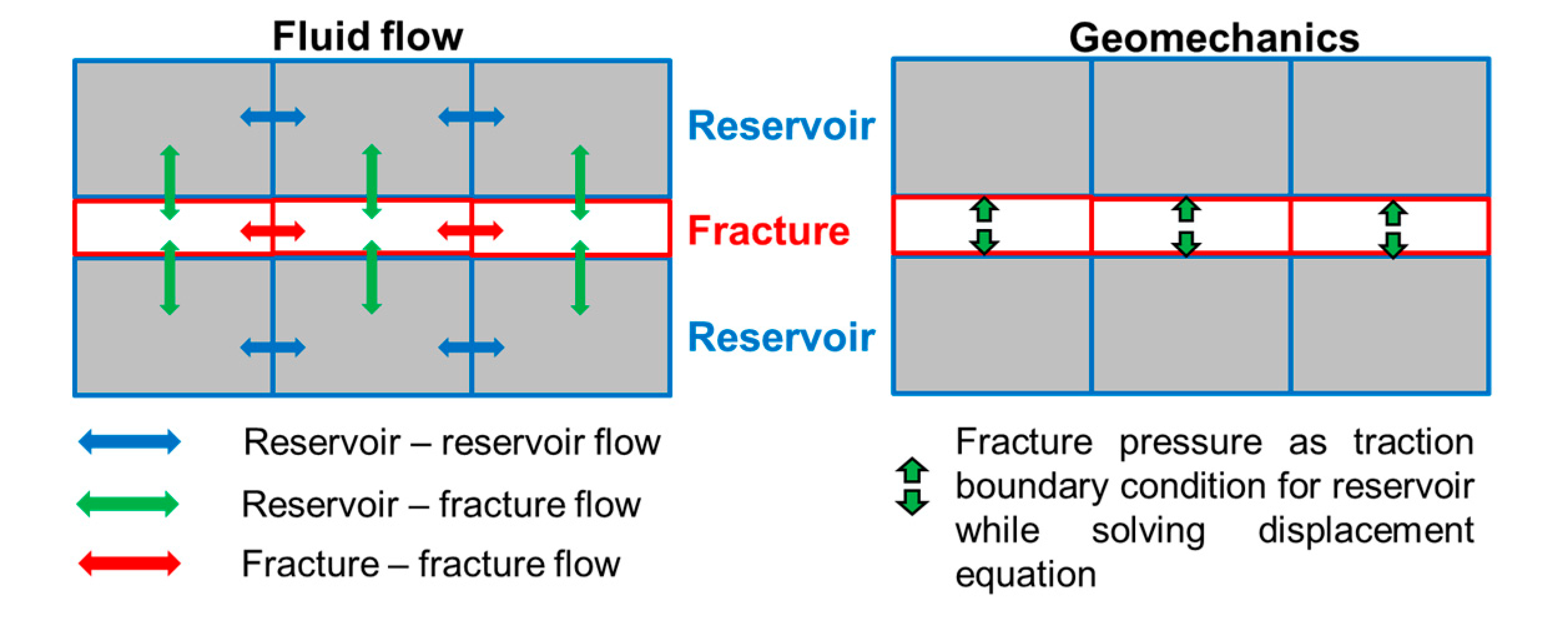














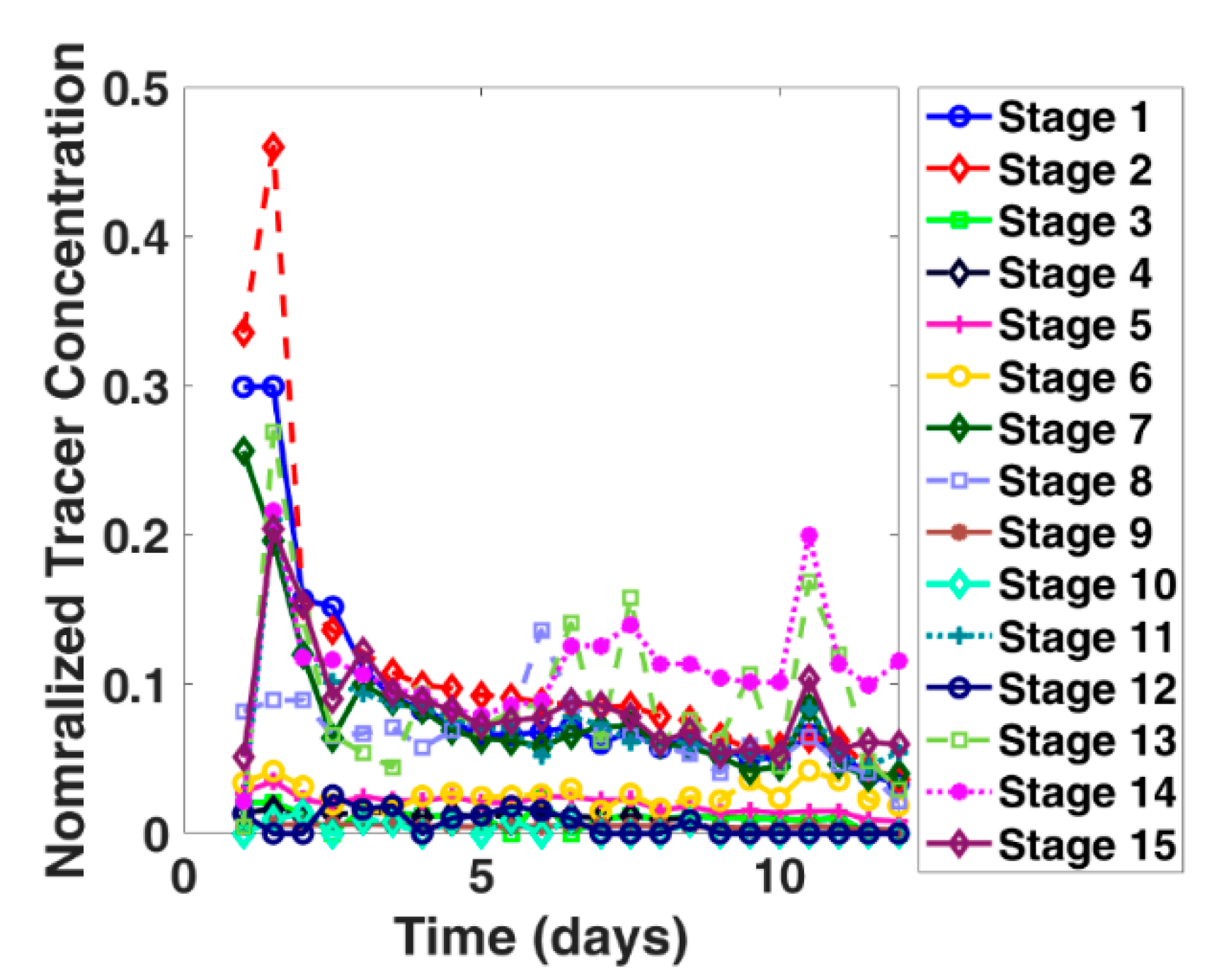





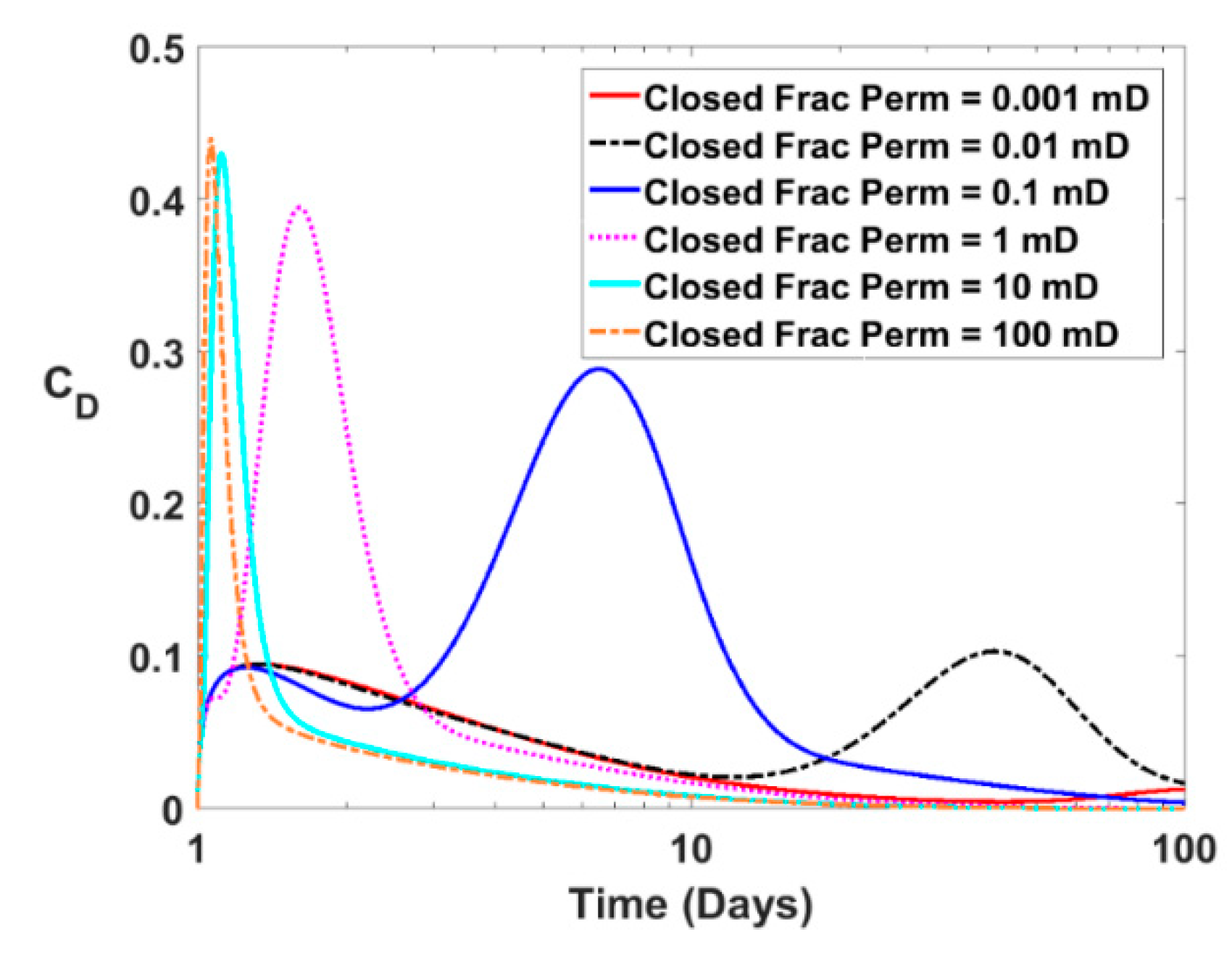
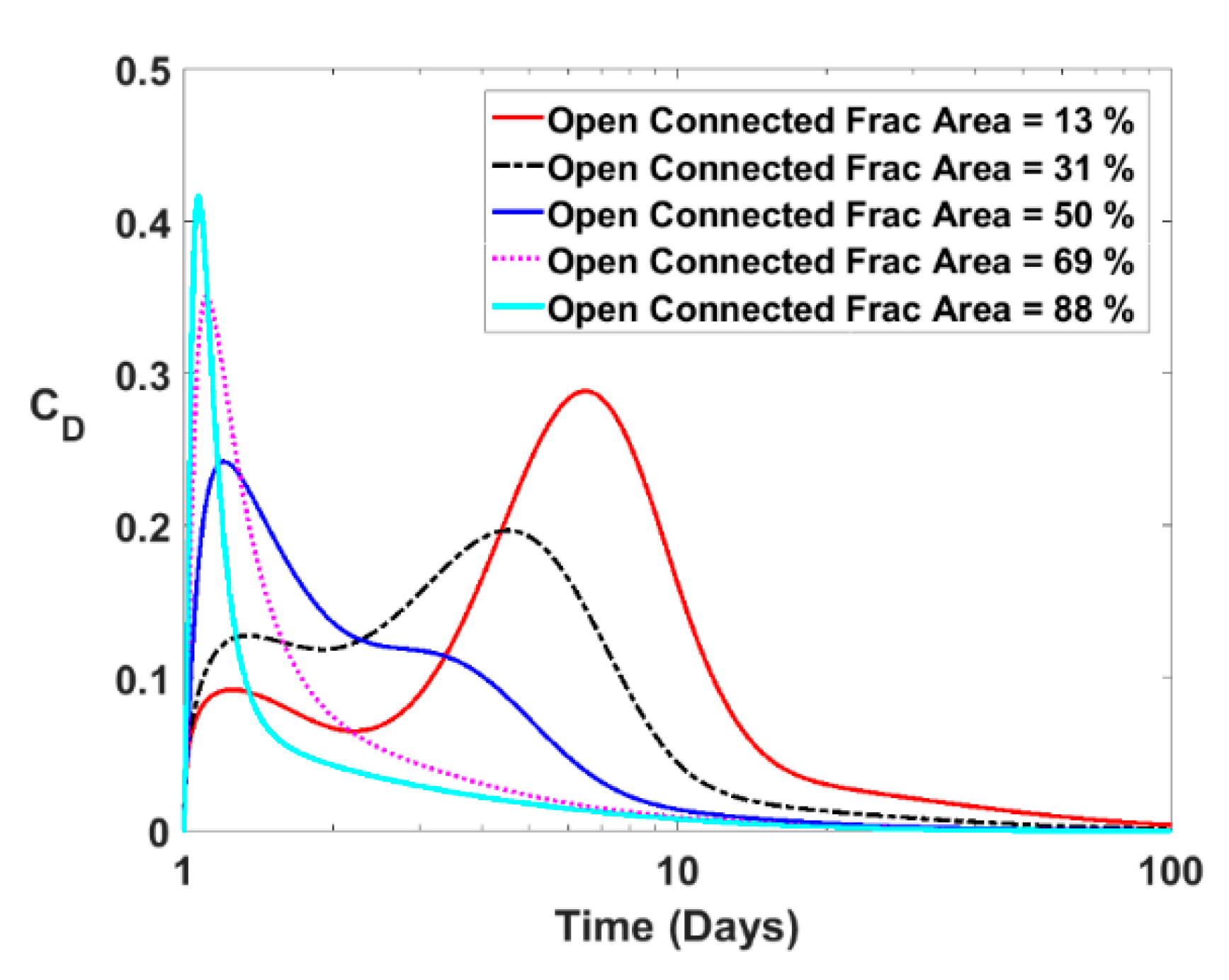

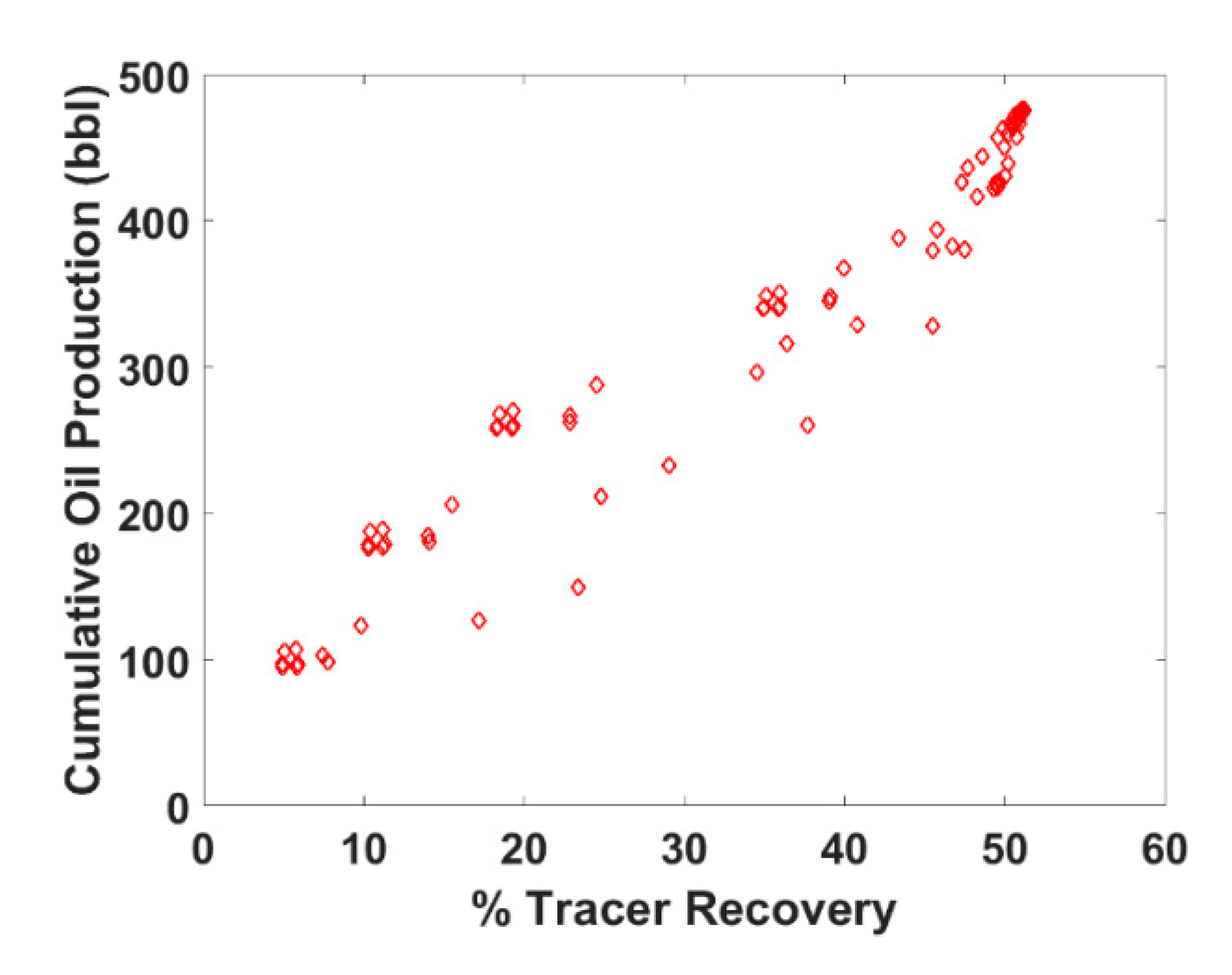


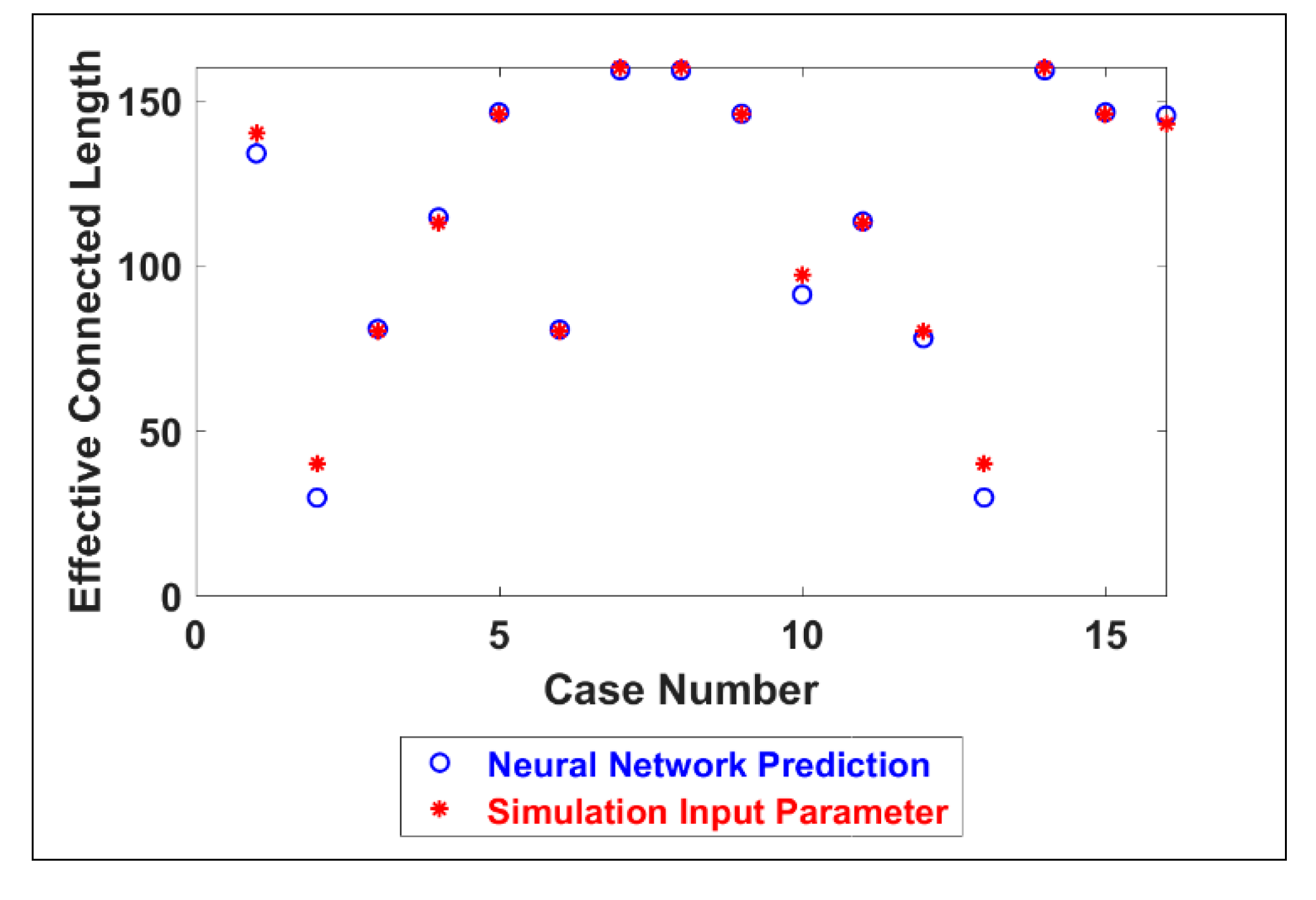
| Property | Value |
|---|---|
| Porosity | 0.1 |
| Reservoir Permeability | Varied from 10 nD to 5 µD |
| Initial Reservoir Pressure | 40 MPa |
| Young’s Modulus | 20 GPa |
| Maximum Horizontal Stress (SHmax) | 52 MPa |
| Minimum Horizontal Stress (Shmin) | 50 MPa |
| Fracturing Fluid Injection Rate | 10−4 m3/sec |
| Total Injection Time | 30 Minutes |
| Injected Tracer Concentration | 0.01 by volume |
| Flowback Pressure | 20 MPa |
Publisher’s Note: MDPI stays neutral with regard to jurisdictional claims in published maps and institutional affiliations. |
© 2020 by the authors. Licensee MDPI, Basel, Switzerland. This article is an open access article distributed under the terms and conditions of the Creative Commons Attribution (CC BY) license (http://creativecommons.org/licenses/by/4.0/).
Share and Cite
Kumar, A.; Sharma, M.M. Diagnosing Hydraulic Fracture Geometry, Complexity, and Fracture Wellbore Connectivity Using Chemical Tracer Flowback. Energies 2020, 13, 5644. https://doi.org/10.3390/en13215644
Kumar A, Sharma MM. Diagnosing Hydraulic Fracture Geometry, Complexity, and Fracture Wellbore Connectivity Using Chemical Tracer Flowback. Energies. 2020; 13(21):5644. https://doi.org/10.3390/en13215644
Chicago/Turabian StyleKumar, Ashish, and Mukul M. Sharma. 2020. "Diagnosing Hydraulic Fracture Geometry, Complexity, and Fracture Wellbore Connectivity Using Chemical Tracer Flowback" Energies 13, no. 21: 5644. https://doi.org/10.3390/en13215644
APA StyleKumar, A., & Sharma, M. M. (2020). Diagnosing Hydraulic Fracture Geometry, Complexity, and Fracture Wellbore Connectivity Using Chemical Tracer Flowback. Energies, 13(21), 5644. https://doi.org/10.3390/en13215644






